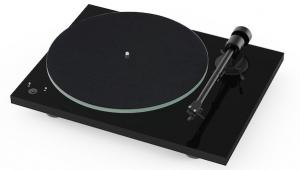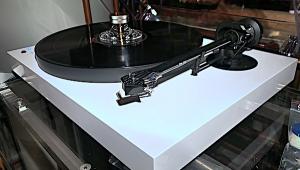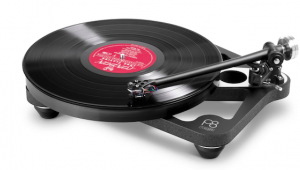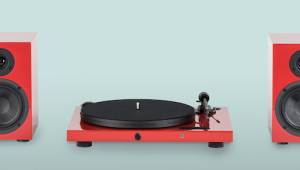Simon Yorke Designs Series 7 Precision LP Playback System Page 2
With its low-torque motor, flexible belt, and heavy platter, the Yorke 'table relies on a degree of initial "slip" for the motor to spin and synchronize. Too tight, and there's not enough slip; the motor won't turn. Too loose, and startup time will be slow and the belt will vibrate too much. Yorke gives you a general idea of where to place the motor and transfer bearing in relation to the platter, but essentially you're on your own. Even optimized, the 'table benefits from a helping hand to get quickly up to speed. There's no variable control. Yorke calibrates every 'table to be "spot on," he says.
I checked speed accuracy using strobe discs and test records in conjunction with a digital voltmeter that can measure frequency in hertz. While the strobe showed speed accuracy to indeed be "spot on" at all three speeds, I was surprised to find that a 1000Hz tone read 1050Hz on the voltmeter. I switched to a CD-sourced tone to check the calibration of the meter and found that it was "spot on." Then I changed test records, and a second LP's 1000Hz tone measured 940Hz! Lesson: If the cutting lathe ain't turning at 331/3, it doesn't matter if your 'table is—the pitch on that record won't be "spot on."
As with the Immedia RPM 2, the Clearaudio Reference, and a few others, the Yorke has no suspension to fiddle with. Easier, but where you put the 'table has a bigger effect on the sound. Yorke sells it in England with a massive piece of slate. In the US, it comes packaged with the Sounds of Silence active Vibraplane.
To play, you simply push the chromed ball on the motor housing and cue up the arm. Ah! That chrome ball...I dare you not to fondle it! Yorke says he leaves his platter spinning all the time; he's not worried about wear or motor failure, and, with a 3½W motor, the electric bill is minuscule. Me? Any excuse to touch that ball...
Even without the arm installed, the Simon Yorke turntable is one compact, handsome specimen. The satiny, almost translucent bead-blasted finish and the shapely, sculpted parts please the eye, and the touch is like that of no other turntable I can think of. Reminds me of the Guggenheim Museum; it wouldn't be out of place exhibited there.
But turntables are for listening, not looking.
The Yorke arm makes a point
It takes but a few minutes to install the unipivot arm on the pre-drilled armboard. The "male" member is fabricated from a 9.5mm-diameter shaft made of a "special grade" of solid stainless steel that can be hardened "under a very specific set of circumstances," Yorke told me somewhat mysteriously. The point is finished to 1;um—you can "kill your granny with it," Yorke joked. Okay.
The female component is a different grade of stainless steel, machined to a V. The granny-killing side is attached to a very finely threaded shaft terminating under the armboard with a wheel that you turn to adjust VTA. A setscrew sunk into the arm's mounting platform locks the shaft in place after you've set your VTA.
The nonanodized armtube (Yorke told me the hardening process also hardens the sound) consists of three parts, the longest one being a straight aluminum-alloy tube that starts life as a large extrusion and is drawn through successively smaller dies until it's the right diameter—important because, according to Yorke, drawn and extruded materials pass vibrations differently from each other. It's damped with a foam insert impregnated with bitumen, a tarlike coal derivative. Arm geometry is based on the SME, with a pivot-to-stylus-tip distance of 233.2mm, an offset angle of 23.64°, and a 17.8mm overhang. Yorke builds a 12" model for transcription-disc playback (ie, Library of Congress applications), but he's dead set against selling it to consumers. In his opinion, a longer arm creates far more problems (increased mass/moment of inertia, resonances) than it solves (lower tracking error, but only if your setup is precise; otherwise, greater tracking error).
The main tube fits into a tapered one (to minimize standing waves), which also receives the stainless-steel counterweight shaft, out of which the "female" part of the pivot is actually machined. The design puts all of that mass directly on the pivot point. Yorke doesn't decouple his counterweight. "I've made decoupled counterweights and I've made rigid counterweights," he told me, "and then I listen to them. If we were at home, I could show you, and in 10 seconds you could hear why I didn't decouple the counterweight."
While that choice is not particularly controversial, how about the Teflon sleeve around which the arm pivots, making it more of a "duopivot"? Judy Spotheim's SPJ arm is another example of a duopivot—in her design, in addition to the main pivot, a tiny bearing pressed into the bottom of a plate attached to the side of the arm rides on a hardened glass platform. Raising or lowering the platform sets azimuth.
On Yorke's arm, the bearing shaft protrudes through a slotted plate suspended below and parallel to the armtube. The slot restricts the unipivot to vertical and lateral motion only—almost like training wheels on a child's bike. The slot edge actually rides on a slippery Teflon sleeve fitted onto the bearing shaft. Now that's different—but not too different.
If you're really paying attention, your first question should be, "Well, if the arm's 'banking' motion is restricted, how do you set azimuth?"
Good question! The answer lies in Yorke's "headshell," which, like the Well Tempered Arm's, slides along the armtube to set overhang, and banks left and right to set azimuth. The "headshell" consists of two discs, each flat on the outside and concave on the inside to make a sandwich with the armtube. The cartridge mounting-screw holes are drilled to provide the proper offset. And if your cartridge's cantilever is "off spec"? There's enough play in the screw holes to compensate for any normal variation.
When you tighten down the cartridge screws, you're also clamping the discs rigidly to the armtube. "The headshell arrangement is the thing I'm most chuffed about," Yorke told me. "It's such a beautifully elegant solution to the most difficult part of an arm—how, at that point, you don't lose rigidity."
Anti-skating is applied via a string/wheel/weight system. Cueing is standard Rega issue dressed up to fit in with the rest of the 'table. The arm is fitted with silver-plated, high-purity copper cable with Teflon dielectric. Yorke routes his cable out of the side of the arm—at the pivot point—which helps restrict any cable-induced resistance to the lateral plane. The fairly stiff cable must be carefully routed to the RCA jacks to avoid tracking problems. The cable attaches to the jacks via long pins and clips, so there's one break between the (high-quality) cartridge clips and your preamp.
Cartridge alignment is relatively easy: Yorke supplies a WallyTractor–like plastic card that describes the arc the stylus must travel across the record for the overhang to be correct, and he gives you parallel lines at the two nulls (where the stylus crosses the zero-tracking-error points represented by a straight radius from the outer edge to the center) so you can check and adjust cantilever zenith. VTA is easy to adjust—but, with no scale, not as easy to calibrate and vary precisely as on some other arms. Adjusting azimuth, too, is easy, but since you're rotating the cartridge around the armtube axis, you're not really rotating around the azimuth axis. In my experience, only the Graham, with its sideweights set at the same angle as the headshell offset, does this correctly.
Methodology & sonics
I know you're getting anxious to know what the turntable sounds like, but you're not just buying sound, you're buying a thing, and you'd better know a lot more than just how it sounds—especially at this price point. I was willing to review the system as a whole, but I also wanted to know how the 'table sounded with a familiar arm. I had Yorke send me an undrilled double armboard—a boomeranglike affair that can simultaneously accommodate two arms, and on which I mounted the Graham 2.0 and Immedia arms. (Thanks to Bob Graham and Immedia's Allen Perkins for their assistance with this.)
Yorke faxed me: "Whilst I will always try and help out people who want to use my turntable with alternative tonearms, frankly I'm not keen to sell turntables in this way if I can avoid it." For the first month or so, I listened to the Yorke arm/'table combo sitting on a Vibraplane active isolation stand using the Parnassus DC, Transfiguration Temper, Koetsu Urushi, and AudioQuest Fe5 cartridges. Yes, an embarrassment of riches that I'm honored to have at my disposal.
Regardless of cartridge, I heard a few easily identified differences between the Yorke combo and the TNT (Mk.IV with the new "airpod" inserts) mated with any of the arms I have on hand. The Yorke clearly had tighter, weightier, more articulate bass, and better dynamic "punch" on bottom, all of which helped give it a more certain rhythmic swagger and overall solidity. And there was no price to pay for this plus: control—the system's ability to stop and start on time was breathtakingly fast. This didn't surprise me, since I mentioned in my TNT review that its weak suit is bass articulation and punch.
But the Yorke also exhibited better focus overall, especially at the back of the soundstage. Its ability to layer focused instruments and voices front to back was markedly superior to the other decks. While it sounded more "lively," it wasn't brighter (though it was, perhaps, a bit less lush). In fact, as I came to discover, the TNT has a narrow-"Q," low-amplitude "brightness zone" that adds detail at the expense of smoothness (like turning up the Sharpness control on a video monitor). How many RCA Living Stereo enthusiasts who complain that Classic Records' reissues sound "bright" are listening on TNTs?
Top to bottom, and much to my surprise, the Yorke offered a more seamless tonal picture, with outstanding high-frequency extension and a complete lack of edge and/or grain. Both instrumental attack and decay had a somewhat more natural feel. The Yorke made me want to play rock music louder and classical music softer.
One track I used throughout my testing was from Public Image Limited's Metal Box, a limited-edition British-pressed set containing three 45rpm records that have awesome, well-recorded bass. There's a track where John "Rotten" Lydon sings some hilarious lyrics—a scathing put-down of a social climber ("everyone loves you until they know you") backed by (Jah) Wobble's subterranean bass and a simple drum track that sounds like just the mixing console's echo bus return. Through the Yorke arm/'table the monstrous bass was perfectly controlled and focused—the fundamental note rang true. Lydon's vocal was front and center in three dimensions, completely free of interaction with the bass, and the echo bus drum track was clearly in focus way at the back of the soundstage. Through the TNT with either the Immedia or Graham arms, the fundamental and overtones blended into more of a blob, and the drum and vocal were caught in the bass undertow.
Yet the Yorke arm/'table rig fell short of the TNT/Graham or Immedia combo in other important areas. The TNT/Graham produced a somewhat wider, more luxurious soundstage with greater "blackness" between notes and instruments, and despite the Yorke combo's superior focus, it couldn't separate the instruments in space nearly as well as the TNT/Graham, nor could it ride the images on the same rich cushion of air the TNT provides. To get the Yorke combo's control and focus you have to give up a bit of bloom, air, and interstitial silence. And you have to live with a more congested soundstage that creates a somewhat less relaxed, less "generous" musical picture. Still, I came away from my month-long listen to the Yorke combo impressed and excited. This is a world-class record player and, despite the few negatives, it sounded more coherent, more musically "right," than the TNT with any arm I used with it.
Did I write that?
- Log in or register to post comments




















































